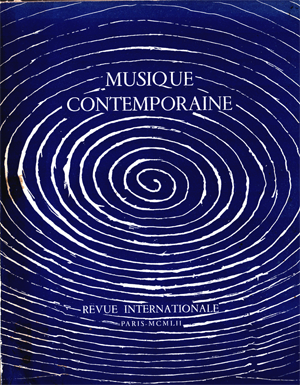Musique contemporaine
Prepared by Doris Pyee, Alexander Hardan, Elise Volkmann
Introduction by Nicoletta Betta
Online only (2022)

Musique contemporaine: Revue internationale [RIPM code MQC] consists of three issues published in Paris between 1951 and 1952: a first single issue (no. 1), a second double issue (no. 2-3), a third and final triple issue (no. 4-5-6), each printed without a specific date beyond the publication year. The periodicity declared at the end of each issue, “Revue paraissant six fois par an” (“Magazine published six times a year”), was clearly never respected. The first and third issue of the journal are 75 pages long, while the second is 105.
The structure of the journal does not follow a regular scheme, as each issue consists of a collection of articles about musical life in Europe with particular attention to contemporary music festivals, such as the Société internationale pour la musique contemporaine (SIMC) festival, held in Brussels, 1950; the Darmstadt international music courses; the Festival of Britain; and the Festival of Donaueschingen. Analysis of, and commentary on, new compositions such as André Jolivet’s Concerto for piano; Benjamin Britten’s opera Billy Budd; Lukas Foss’s Concerto for piano and orchestra; and Andrzej Panufnik’s Peace Symphony are accompanied by partial manuscript reproductions and sketched portraits of their composers. Significant space is given to full page illustrations, including artworks by Jacques Villon, Henri Matisse, Georges Braque, Henry Moore, and William Alwyn. Aphorisms on artistic themes frequently appear.
The founder of Musique contemporaine was Tsveta-Maneva, pseudonym for Esteva Maneva (b. Pazardijk, Bulgaria, 29 January 1906 – d. Paris, 17 August 1952), a journalist about which little information could be discerned. An apparent participant in the cultural milieu of Paris, Tsveta-Maneva was personally acquainted with Henri Matisse, whose pencil portrait of her is published in the first issue of Musique contemporaine. She corresponded with the Italian composer Gian Francesco Malipiero, whose correspondence is now preserved at Fondazione Cini in Venice. To launch the new journal she contacted personalities of the international contemporary music world; the opening pages of the first issue display letters and telegrams in response to her appeal, containing well wishes and appointments to the Comité d’Honneur by Arnold Schoenberg, Malipiero, Nezil Kazim Akses, and Panufnik. As a writer, she contributed articles on the Venice Festival of 1950 and the orchestration of Ravel’s piano work Jeaux d’eau by the Argentinian composer Carlos Viacava.
It is not possible to identify all regular contributors as Musique contemporaine appears to have been an editorial initiative of Tsveta-Maneva alone who solicited contributions from her network of acquaintances in the musical and artistic fields. Of interest are the articles by Herbert Barth about the 1950 Bayreuth international conference, Humphrey Searle on the British music renaissance between 1900 and 1950, Boris de Schloezer on Bach and new music, Vladimir Ussachevsky on young North American composers, Henry Dutilleux on the SIMC festival 1951, and René Schaeffer on musique concrète. A significant group of contributions came from Italy, with Gian Francesco Malipiero on the premiere of Stravinsky’s The Rake’s Progress, Guido M. Gatti on Malipiero’s theatrical works, Massimo Mila on Dallapiccola’s new opera Il Prigioniero, and Roman Vlad on music and cinema.
In the “Avant-propos” (“Foreword”) to the first issue of Musique contemporaine, Tsveta-Maneva affirms that a key point of the new journal is “montrer aussi les liens indéniables existant entre la Musique et les autres Arts” (“also show the undeniable links existing between Music and the other Arts”). As such, visual arts are a key focus of the journal, which, besides the aforementioned drawings, contains several sketch portraits of musicians such as Charles Munch, Lukas Foss, Hans Werner Henze, Goffredo Petrassi, and the partial reproduction of manuscript scores of new compositions by Roman Vlad, William Alwyn, and Barbara Pentland, among others. The image on the cover page is signed by Jacques Villon, brother of Marchel Duchamp and an abstract painter himself, to whose work Tsveta-Maneva dedicates an article in the first issue of the journal. The premature interruption of publication following the third issue is certainly due to the death of Tsveta-Maneva.
This RIPM Index was produced from copies of the journal held by the Westminster Music Library (Westminster, United Kingdom); Virgil Thompson’s personal copy held by Yale University, and a private collector.
